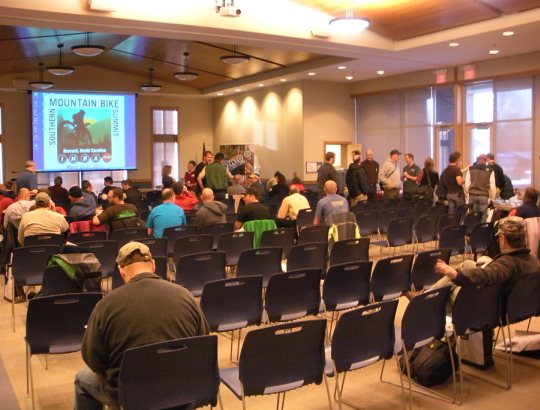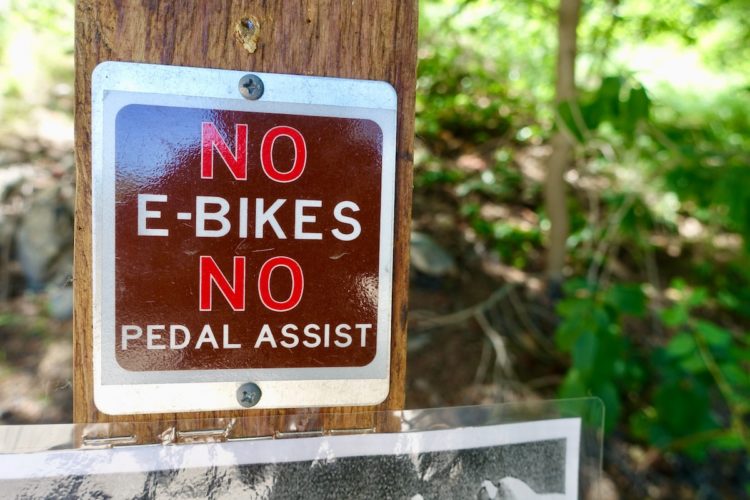This is the second part of my coverage on the Southern Mountain Bike Summit that was held in Brevard, NC recently. In case you missed it, find the first part here. Okay, let’s get on with it.
Building Partnerships to Get Things Done
Day two started with a really good presentation by Sig Hutchinson, the president of TORC and owner of Sig Hutchinson Communications. Sig knows how to get things done. He is a mover and shaker in his community in Raleigh, NC where he is largely responsible for raising $140 million for open space preservation, parks, and an incredible greenway system that links several communities and parks together in Wake County. The system currently has about 70 miles, and there’s another 40ish currently under construction. Who wouldn’t want something like that in their town!?
Sig’s presentation focused on how to deal with people to build partnerships. As volunteer groups, mostMTB clubs are very willing to ask for things such asdonations, land to build trails on, access to existing trails, etc. But we don’t always think of ways to give back to the people that help make those things happen. Sig talked a lot about how people are under appreciated. So when we work with someone, we need to give them credit for what they do to help us. Get the media involved, send out press releases, let people know about the good work that person did. They’ll be a lot more willing to help you again later if you do.

People slowly filing into the room Saturday morning. Half an hour later the room was packed out.
Working With the USDA Forest Service
This was another panel session where several people gave short presentations. One thing I quickly learned is we actually have some good cycling advocates who work for the Forestry Service. One of the speakers, Jim Schmid is a Trails Manager for the Forestry Service who was a mountain biker before mountain biking even existed.Back in the 70’s he didn’t own a car so he biked everywhere and he was the first person in his town to buy one of the1982 Specialized Stumpjumpers (the first widely available mass-produced MTBs) and he’s even cycle toured around Europe. He is a true bicycle fanatic – and it’s great to have people like him working on the inside withus.
The big take-away from this session was that the Forestry Service is a multi-management agency. They have a lot to deal with, including:conservation, restoration, timber, fire management, recreation, and wildlife justto name a few. So again, patience when working with them is important. Things take time, and we need to realize that. Even when they get behind a project 100%, it will not happen quickly. And they do like working with volunteer groups such asmountain bike clubs; without us working with themthere would be a whole lot less trails for us to enjoy. The southern region of the Forestry Service has over 10,800 miles of trails! Without volunteers to help maintain them that number would be much, much smaller because the Forestry Service simply doesn’t have the budget or manpower to do it themselves.
Creating Great Trails and Communities
This session focused on why we need trails in our communities. Trails offer a lot of benefits to communities aside from being a place to have fun. They’re cheaper than other recreational facilities, they preserve wildlife habitats, they can revitalize derelict property, and they can be an economic boom to communities that embrace them. Trails also get people exercising and create healthy lifestyles. One statistic given was that 55% of trail users exercise more than before they had access to trails. In other words, trails get people off the couch and outside getting healthy. This presentation also gave tips on how to turn your trailsinto a destination trail system – somewhere people will travel to from far and wide to ride. The speakers offered tips on what the trails should offer, the types of lodging trail users will need, and even how to advertise and market your trails.
IMBA Club Care
The final session of the summit was another Trail Care Crew presentation – how to build a sustainable mountain bike club. And once again, Steve and Morgan did a great job with this presentation. They gave advice, learned from successful clubs around the country, on how to increase membership, organize meetings, and avoid volunteer burnout. They also explained why clubs should put on events, and how different events work better to reach certain goals. For example, hosting a skills clinic would not be a good fundraiser, but it would be good at building a riding community and growing club membership.

The Trail Care Crew spent some time with Upstate SORBA before the summit. Photo: Upstate SORBA.
Up Next
That wraps up my coverage of the learning sessions. As you’ve seen, there was a LOT of information thrown at us in those two days. Find out if a regional summit is coming to a town near you, and if so, go check it out! There is a ton of knowledge to gain at these summits and it will only benefit your local club and riding scene if some of your folkscan attend.
In my third and final post on the Southern MTB Summit I’m going to present my big take-away, the overall impression I was left with at the end of the summit. There will also be a ride report from Friday afternoon’s ride – these things aren’t all work you know!



















